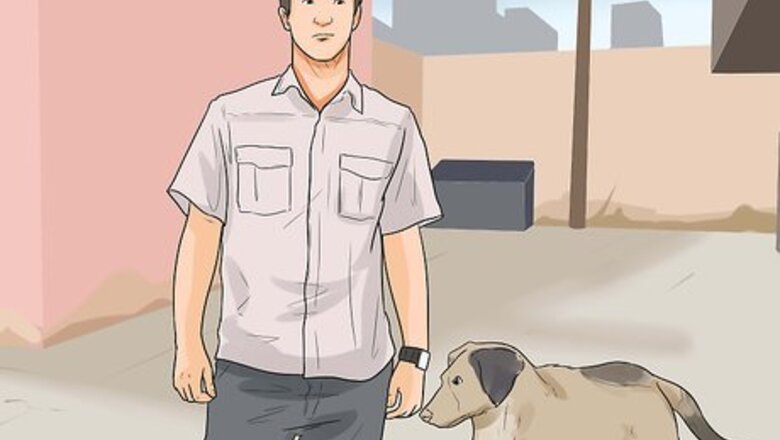
views
Encountering a Stray Dog
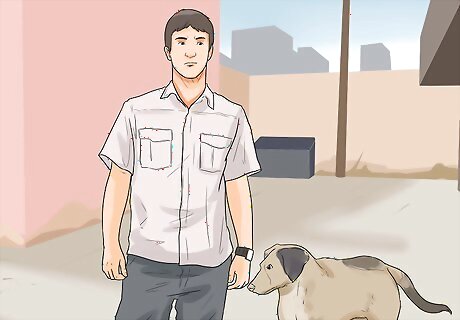
Remain as still as possible. Stray dogs tend to be very fearful. Any sudden movements you make, or even just moving toward him normally, could look threatening to them. In turn, their 'fight or flight' response will be activated, causing him to turn and run away from you. Staying still will allow him to see that you are not a threat to him. If he approaches you when you are standing still, allow him to smell you. Do not hold your hand out for him to sniff it. He may bite your hand out of fear. Resist the temptation to pat your leg to get the stray dog to come to you. He may interpret that as a threatening movement. Even if the dog is displaying aggressive behavior, remember that he is likely more afraid of you than you are of him.
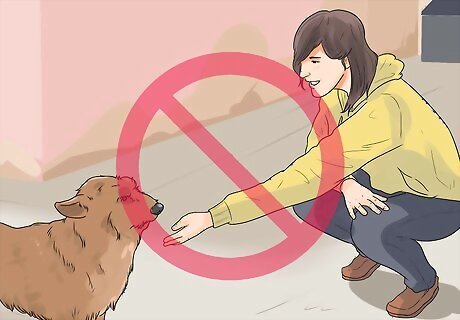
Avoid calling the stray. Depending on how long the dog has been a stray, he may been called repeatedly by people—even his owner—trying to catch him. Over time, he may have developed a negative association to being called. Thus, if you call him to get his attention, he may run off in fear. If you are trying to get his attention, consider using noises that are more calming, such as clearing your throat or faking a sneeze. You could also lick your lips or yawn to convey that you are not a threat to him.
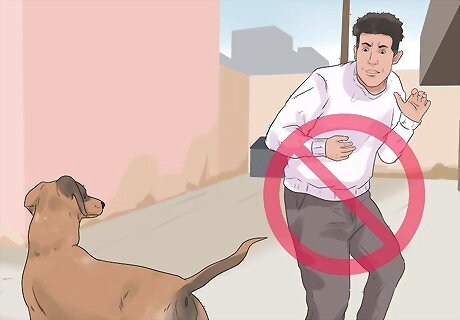
Do not run away. If the stray dog is demonstrating erratic or aggressive behavior and you become fearful, fight the temptation to run away. If you start to run, chances are good that he will chase you. In addition, if you run away from him, you will have your back to him, which will put you in even more danger. If you want to distance yourself from him, walk away slowly and do not turn your back on him.

Call your local animal control. If you are uncomfortable around the stray dog, or are unsure of the safest way to catch him, call your local animal control or a professional dogcatcher. Provide as much information about the dog as you can, such as the location of the dog (e.g., landmarks, street signs) and his breed. If you can, send photos of the dog to the animal control center or professional dogcatcher. Leave your phone number with the dispatcher, and inquire about how long it will take someone to come to you. Keep your eye on the dog until help arrives. Make your own safety a priority—do not attempt to interact with a stray dog that is displaying erratic or aggressive behavior.
Catching a Stray Dog Without Setting a Trap

Entice the stray dog with food. Food is a great way to encourage a stray dog to come closely enough to you to catch him. Fill an empty, crinkly bag of chips with treats that a stray dog would likely love, such as hotdogs or bits of pizza. Where the dog can see you, loudly crinkle the bag and drop the food on the ground. Pretend like you are picking the food off the ground and eating it yourself. The stray dog will likely become curious at your actions and begin walking toward you. To appear less threatening, sit on the ground while you are enticing him with food. Be aware that stray dogs may have a decreased sense of smell. Therefore, he may not be enticed by the food, no matter how tasty or smelly it is. If you are driving and happen to see a stray dog by the side of road, pull over safely and try to entice him into your car with food. EXPERT TIP Sheri Williams Sheri Williams Certified Dog Trainer Sheri Williams is a Certified Dog Trainer and Behaviorist and the Owner of sheriwilliams.com, a business that specializes in teaching veterans how to turn their dogs into service dogs or emotional support animals to assist with PTSD. Based in the Los Angeles, California metro area, Sheri has over 20 years of dog training experience and also runs a general dog training practice specializing in rehabilitating dogs through positive reinforcement training techniques. She is certified by The Animal Behavior and Training Association. Sheri Williams Sheri Williams Certified Dog Trainer If you find a stray dog, try to locate the owner. If a stray dog comes to you willingly, try to safely catch it and check for ID. If you find a number, call the owner if you can. Otherwise, take it to a veterinary clinic in case it has a microchip with owner info.

Use a dog catch pole. A dog catch pole is a humane way to catch a stray dog. However, you should use it only if your own safety will not be at risk when using it. Before trying to catch a stray dog in this way, set up a crate nearby in which you can place the dog after catching him. Make the crate comfortable by setting blankets inside of it, along with some food and water. If you can entice the stray dog with food, allow him to come closely enough to you where you can quickly hook the pole around his neck. Move him quickly to the crate when you have hooked him. Release the pole when he is safely in the crate. Do not make eye contact with the stray as you are catching him. The stray would perceive this as a threat. If your local pet store does not carry dog catch poles, ask the store's staff about where you could purchase one.
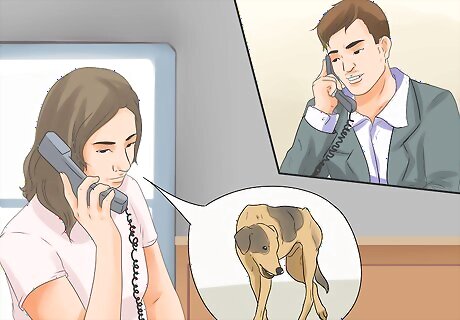
Call animal control. If you are not able to transport the stray dog to an animal shelter yourself, call your local animal control center. If you were able to entice the stray dog into your car with food, call animal control immediately. It can be dangerous to drive with an unrestrained stray animal in your backseat.
Using a Humane Trap to Catch a Stray Dog
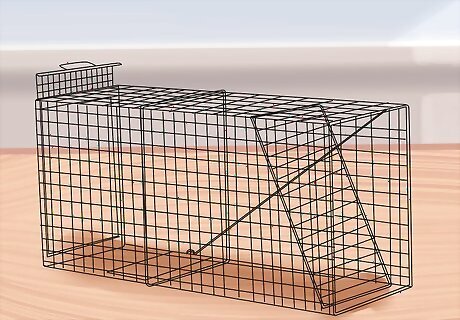
Obtain a trap. Traps come in a variety of shapes, sizes, and configurations. A store that sells hunting equipment will likely have traps available for purchase. If you do not want to purchase a trap, consider calling your local animal shelter or animal control center to inquire about renting or borrowing a trap. When asking someone for help to obtain a trap, provide as much information as you can about the dog. This will help you select the appropriate trap size and configuration.
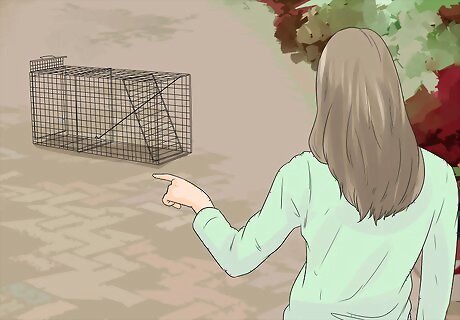
Place the trap in a good location. The trap should be in an area where the stray dog frequents. Ideally, this area should be where the stray dog would be comfortable approaching without feeling threatened. In addition, you should place the trap where you could monitor to it without trespassing on personal property or being otherwise obtrusive. Set the trap on a firm, flat surface.
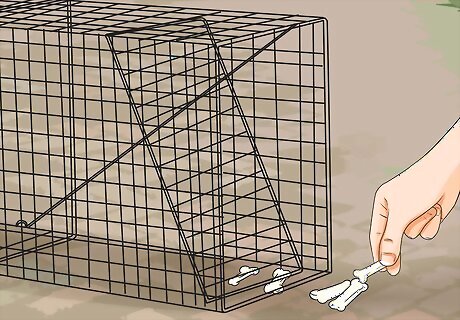
Set up the trap. It is important for the trap to be inviting to the stray dog. If he does not feel comfortable around it, he may approach it but not walk in it. For example, cover the trap with blankets—this will help him feel safer when he steps inside of it. Also, place several layers of blankets on the bottom floor of the trap for increased comfort. If you set the trap directly on grass, place a sturdy waterproof barrier under the trap to keep water from getting in and soaking the blankets. A dog-catching expert could advise you on what type of barrier would be best. Place tasty food in the trap. Examples of good food include pizza, hot dogs, and various meats (e.g., boneless chicken, beef, liver). Hide the trap mechanism with blankets. The trap mechanism is like a hill. If the stray dog sees it, he will not step on it. With enough blanket cover, he would step on the mechanism and not even realize it, thus securely trapping him within. Clear away any objects (e.g., rocks, pinecones, leaves) from the trap entrance that could prevent the door from closing. Set the trap out when the stray dog is most likely to start roaming: dusk, dawn, or midnight.
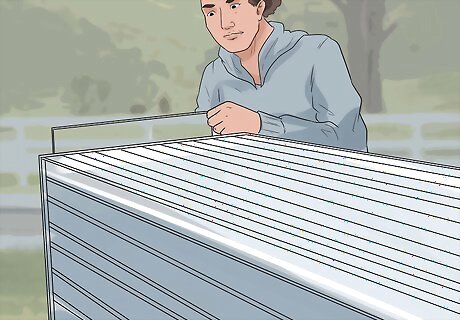
Test the trap. Be sure the trap closes properly before leaving it for the stray dog. To test the trap, use your hands to apply pressure to the trap mechanism. If you have a dog that is a similar size as the stray, have him walk into the trap. If you think the stray dog is too small to set off the trap mechanism, place an extra weight (e.g., rock, brick) on the side of the mechanism.
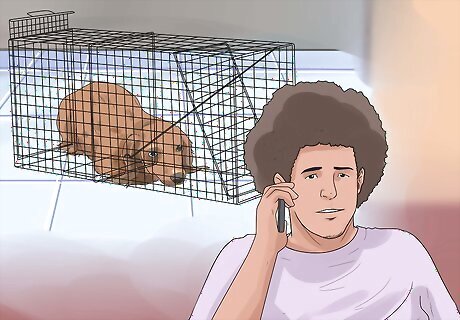
Check the trap. Check the trap the day after you have set it up for the stray dog. If you see him in it, contact your veterinarian, a local animal shelter, or your local animal control center for further instruction. If you are able, transport the stray (still within the trap) to your veterinarian, shelter, or animal control. If the stray is not in the trap when you check it, prepare the trap again for another day. Keeping your eye on it will be important to keep other animals from going inside the trap. If other animals are in there, the stray dog will likely not go near it.
Knowing What to Do After Catching the Stray Dog

Report that you found the dog. In many places, you cannot automatically assume ownership of a stray dog. There are several ways to report that you found a stray dog: contacting your local animal control center or animal shelter, putting up 'Found' signs throughout your community and in your newspaper, and posting a picture of the dog on animal rescue sites (e.g.,https://www.petfinder.com/).
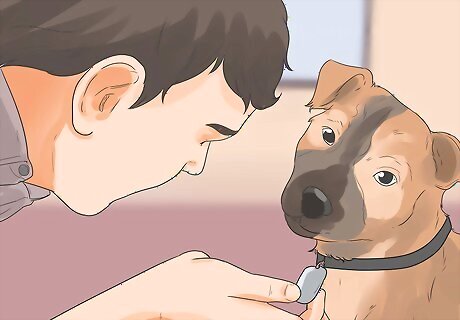
Check the stray dog for identification. If the stray dog has a collar with an identification (ID) tag, look for his name, along with the name and contact information of his owner. If you do not see an ID tag, take him to a veterinary clinic, animal shelter, or animal control center where he could be scanned for a microchip. If you can obtain the owner's contact information, contact the owner immediately to let him or her know you found his or her dog. You can then arrange a time and place for the owner to pick up the dog. You should make every effort to reunite the stray dog with his original owner.

Consider the limitations of an animal shelter or animal control center. If you are unable to find the stray dog's owner, but do not feel like you can care for the dog, transferring him to animal shelter or animal control center may be a reasonable option. However, either of these places will likely have significant budgetary and resource limitations. Animal control centers or shelters may not be able to house rescued animals for long time periods, and may have a policy to euthanize animals who are not claimed or adopted within a certain timeframe. Research different shelters to find out which ones have available space. You may also want to consider transferring the stray dog to a 'no kill' shelter.
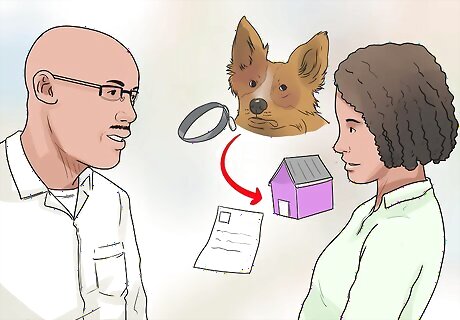
Consider adopting the stray dog. Adoption is another option if you are not able to locate the stray dog's owner. Before claiming ownership, there will likely be certain requirements you will have to meet. For example, you would need to wait for a designated holding period—the period during which the dog's original owner can claim him. Ask at your local animal control center or animal shelter about how long the holding period is. If the owner has not claimed the dog within the holding period, you would proceed with establishing yourself as the legal owner of the dog. You would purchase a collar and ID tag, make sure the stray dog is properly vaccinated, and have him licensed. Consider the expense of adopting the stray dog, especially in terms of veterinary care. You would be responsible for veterinary care expenses, so determine if you would be able to take on this financial commitment before deciding to adopt. If you decide to adopt, create a comfortable and stress-free home environment for the stray dog. It is also important for you to show him love and attention, and allow him the space and time to become more comfortable with you.
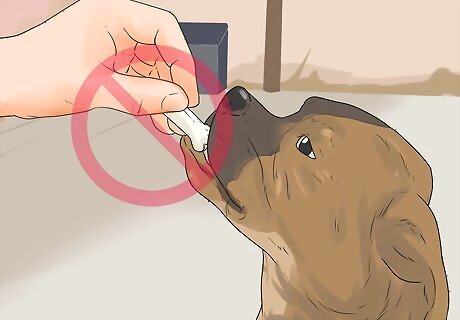
Do not feed the stray dog. Stray dogs are usually hungry, so you may be very tempted to start feeding him. Apart from enticing him with treats, feeding him may not be a good idea for several reasons. For example, a stray dog has likely become accustomed to eating scraps or hunting for his food. Feeding him commercial dog food may lead to digestive problems. The stray dog may have rabies. If he bites you when you are offering him food, there is a real danger of rabies transmission.




















Comments
0 comment